WESTWOOD, WILTSHIRE
Westwood Manor and St. Mary the Virgin
Grid Ref: ST 815 590
8 June 2005
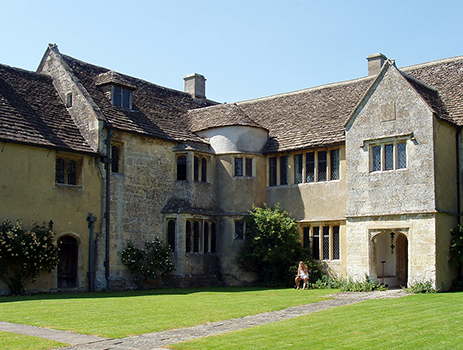 |
|
 |
| Westwood Manor showing west wing |
|
Central Range of Westwood Manor |
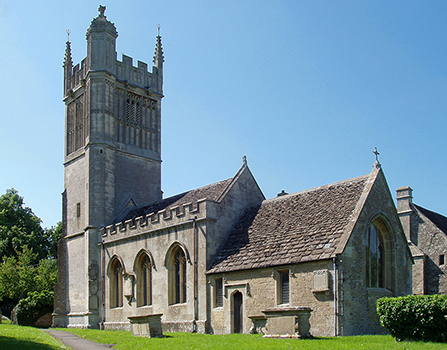 |
|
 |
| St. Mary the Virgin |
|
Detail on arch above the main entrance |
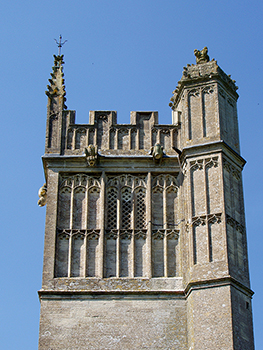 |
|
 |
| The Tower |
|
Ceiling of the church |
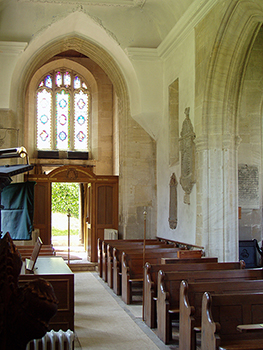 |
|
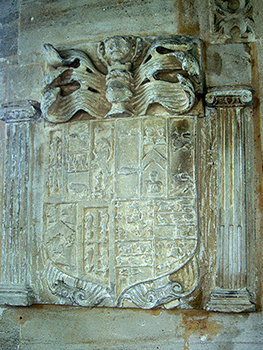 |
| View down the nave to the west door |
|
Carved shield with Bushe crest |
Westwood Manor
Westwood is mentioned in Saxon charters of 983 and 987. King
Ethelred granted land first to Aelfnoth and only four years later to his huntsman
Leofwine although it is not clear that this is the same land. The manor was
given by Queen Emma, the mother of Edward the Confessor, or possibly by her
stepson, King Harthacnut, to the priory of St. Swithin's at Winchester, whose
monks were the chapter of the cathedral. The Domesday survey of 1086 shows
the land still in the hands of the Bishop of Winchester. In the early 1200s,
the the monks leased out some or all of the lands rather than farm it directly.
In brief, various phases in the construction and modification
of the manor were the responsibility of Thomas Culverhouse, who took over
the property in 1470; Thomas Horton who obtained the lease in 1518, and John
Farewell who acquired the manor in 1616. At the Dissolution, the manor of
Westwood was given to the Dean and Chapter of Winchester Cathedral. Details
of the changes are given in the National Trust booklet. The last owner was
Edgar Graham Lister, born in 1873, who was in the Foreign and Diplomatic Service.
He took over the property when it had been in use as a farmhouse since at
least 1833. He was responsible for restoration and improvements including
panelling in the King's Room brought from Keevil Manor in 1910. The dining
room was panelled with wood from a house in Bristol. Mr. Lister died in 1953
leaving the house, his collection of furniture and an endowment to the National
Trust. The house has many interesting features and I recommend a visit. On
a sunny June afternoon the setting is idyllic.
St. Mary the Virgin, Westwood
According to the information provided for visitors, there are
few contemporary documents describing the church. The patrons are the Dean
and Chapter of Bristol cathedral and it is believed that this has been the
case since the Diocese of Bristol was established in 1540. Other sources indicate
that Westwood was a chapelry of Bradford-on-Avon since at least 1299. It became
a parish in its own right in 1884. The date of construction is not known but
the tower and lady chapel in the north aisle were constructed in the late
15th or early 16th century. The tower is magnificent with its traceried windows,
gargoyles, pinnacles and a stair turret with a small dome. There is
the monogram TH in the spandrels of the west door. One suggestion is that
these might relate to Thomas Horton of Iford while another suggestion is that
they relate to Thomas Hungerford of Farleigh Hungerford. The pulpit of 1607
was moved from Norton St. Philip' s by Canon Jones who discovered it in Tellisford.
The nave was rebuilt in 1786 and the south wall of the chancel
was rebuilt about 1840. The restoration in the 19th century by Canon Jones
removed all the plaster from the walls with the loss of inscriptions and frescoes.
The west gallery was also removed at this time. The western half of the ceiling
was replaced at some stage by lath and plaster and in 1968 this was restored
to match the eastern half but without the carved woodwork, as shown in my
photograph. The shield on the north wall contains the arms of Bushe, Dalwyn
or Dynland, Ryd or Ryde, Vaughan, Strange, Fernfold and Horton with the Bushe
crest. These quarterings arise from the marriages of women from these families
into the Bushe family. The shield is a fairly uniform colour and I have digitally
enhanced the contrast in my photograph to try to show more detail.
Sources:
Westwood Manor, Wiltshire, The History of the House and its Inhabitants,
by Denys Sutton, The National Trust, 1999.
Information for visitors in the church.
The King's England, Wiltshire, by Arthur Mee, published by Hodder and
Stoughton, first edition, May 1939, new and revised edition, 1965, ISBN 0
340 00107 0







